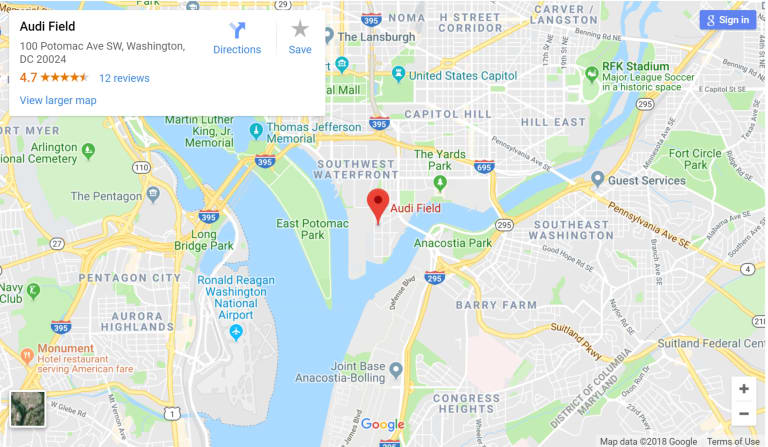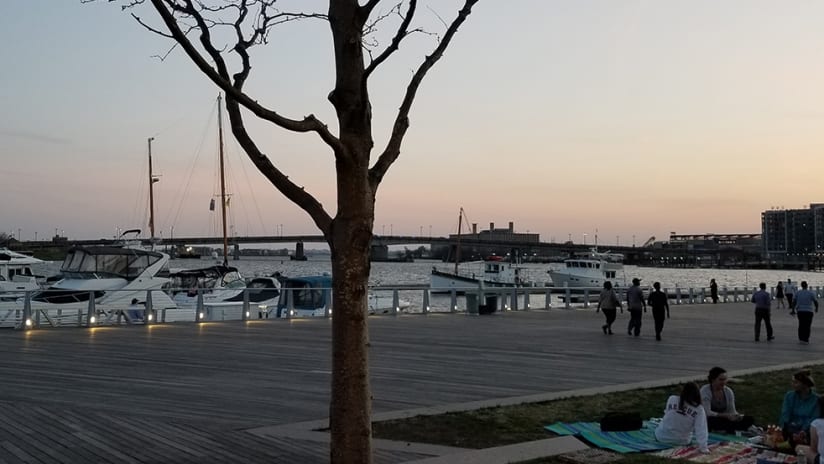WASHINGTON – Traditionally, guidebooks and tours of the capital city of the United States do not include the Southwest Water Front in their itineraries. And that’s putting it mildly.
The quiet peninsula where the Potomac and Anacostia rivers meet has been an overlooked corner of the District of Columbia for the past two centuries. Swampy and flood-prone in the olden days, and more recently cut off from the city’s core by the elevated Southeast/Southwest Freeway, that area of D.C. was once considered so remote that it was dubbed “The Island” by local residents, despite sitting barely two miles south of the U.S. Capitol.
Over the decades it’s been home to farms, shantytowns, illegal prizefighting, a brickmaking factory, trash dumps, a military arsenal, a prison, a power plant, a scrapyard and boat marinas, among other things. In 1886 a Washington Post reporter named Russell Gray visited the area and wrote, “I do not believe that five strangers a month ever find their way into this extreme southern end of town, and I hope I will not be accused of lack of pride in the growth of the city when I say that a real-estate boom probably never set foot among the long levels of that section.”
Times have changed, Mr. Gray.

This weekend D.C. United will christen the neighborhood’s newest and most keenly-anticipated arrival, Audi Field, with a match against the Vancouver Whitecaps (8 pm ET | TSN – Full TV and streaming info). That part you probably already know about: One of MLS’s founding clubs, and one of its most successful in terms of overall trophies (and by a few other metrics too), is at long last moving into a gleaming, intimate, downtown home that’s truly their own.
Audi Field would be a big story for D.C. United and MLS wherever it wound up being built. As you may have heard me emphasize in past columns, this is a soccer-obsessed community and United were this league’s first great success story. So Saturday’s game is something akin to Moses reaching the promised land, and instead of dropping dead on the mountaintop, strolling down to it and enjoying a cold beer and a spirited kickaround.
But this stadium isn’t just anywhere. It sits at the nexus of what might be the most ambitious long-range urban design project in North America right now.
Over the past few years a group of planners and developers have led a dramatic series of projects that aim to make D.C.’s Southeast and Southwest riverfronts an alluring destination for locals and tourists alike, whether they’re seeking a night out or a place to live and work. Nationals Park, the sleek baseball stadium four blocks constructed at a cost of over $700 million a decade ago, is a prime anchor.
So is “The Wharf,” a highly ambitious $2.5-billion mixed-use mega-development whose first phase opened last fall, featuring inviting public spaces, a boating dock, hip bars and restaurants and The Anthem, a $60 million live-music venue (Janelle Monae plays there next week; the likes of Father John Misty, Beach House and New Order roll through for dates next month).
And Audi Field.
United’s new home lies between the other two and is envisioned as the latest pearl in a string of riverside attractions that will eventually run from posh Georgetown five miles to the northwest all the way down and around to RFK Stadium, the beloved old wreck on the east side of town that will be replaced by some manner of mixed-use development in the years to come. The city's leaders also hope to convince Amazon to pick the area for the site of its new headquarters.
You can already walk or bicycle (or perhaps, like Zlatan, you prefer roller skates) most of the way along this sweeping crescent of gorgeous views and varied neighborhoods. Or if you’re the nautical type, you can take a similar route by water; for those seeking a less conventional commute to Audi Field, a network of water taxis runs between Nationals Park, the Alexandria waterfront and National Harbor to the south.
Speaking of bikes and boats: They’re by far your best bet for getting to and from Audi Field, alongside public transportation and a comfortable pair of shoes. Anything but a car, really: The venue has precious little parking of its own and Nationals Park’s garages are a healthy walk to the northeast. Whether United supporters start their own “march to the match” tradition like Seattle’s remains to be seen.
Located less than a mile from two Metro stations, with a Capitol view built into its design, Audi Field is a profoundly urban ground, shoehorned onto a snug pocket of land that required an asymmetrical design with more seating on the east side than the west. And as a result, it gives you a sensation that you usually have to go to Europe or South America to get – turn a corner and boom, there it is, nestled into its surroundings without the acres of parking lots that typically isolate stadiums from their neighbors.
The closest MLS comparison might be Portland’s Providence Park, and if United can foster a rich supporters’ culture like the Timbers have, it could soon offer a very similar experience. That said, Audi Field’s immediate neighborhood is, for now, a bit sparse in terms of things to do, although waterfront views are never far away and the area offers a range of pleasant spots.
Did you know D.C. is home to a Titanic Memorial? Yes, and the 1930s-era sculpture is half a mile from D.C. United’s new ground. Those with kids in tow could head the other direction to Yards Park, where splash fountains, a wading pool and faux waterfall delight young ones on hot summer days. All around are the Navy Yard district’s rapidly-growing range of food and drink options, though the most striking spot might be the Boilermaker Shops, a cluster of restaurants and shops in a glassy warehouse that once housed naval ship-building operations during World War II.
If you seek an easy place to meet up before a game, Field House DC is an open-air spot in the shadow of Audi Field offering beer, wine and a rotating cast of food trucks. Two blocks south, United’s Screaming Eagles supporters group will try to continue the RFK Lot 8 tailgate traditions of old at the Matthew Henson Earth Conservation Center, an indoor/outdoor space right on the Anacostia that is, fittingly, also home to a program that reintroduces bald eagles and other birds of prey to an ecosystem once too polluted for much of anything to survive.
Sitting around the bend from Chesapeake Bay and shot through with rivers, marshes and creeks, some of them even underground, D.C. and its surrounding environs is a watery place. But for a variety of reasons, for decades its leaders treated all that riverfront space like more of a nuisance than a resource.
That’s changing in a big way, and D.C. United’s new home is at the heart of it.
But the Black-and-Red also have some cherished traditions – not to mention a packed trophy case – to transfer from RFK to Audi Field. So if you’ve got time, pedal a few miles north along the West Bank of the Anacostia Riverwalk Trail, past Capitol Hill and the Historic Congressional Cemetery, and you’ll reach RFK, the decaying but beloved bowl where the club and its fans made North American soccer history over the past 22 years.
“Study the past if you would know the future,” read the tifo displayed by D.C. supporters at their final game at RFK back in October, reminding the rest of MLS just where “America’s soccer capital” really is. A new era has arrived for the club, its city and its waterways, and you might be surprised what takes shape in the years ahead.













